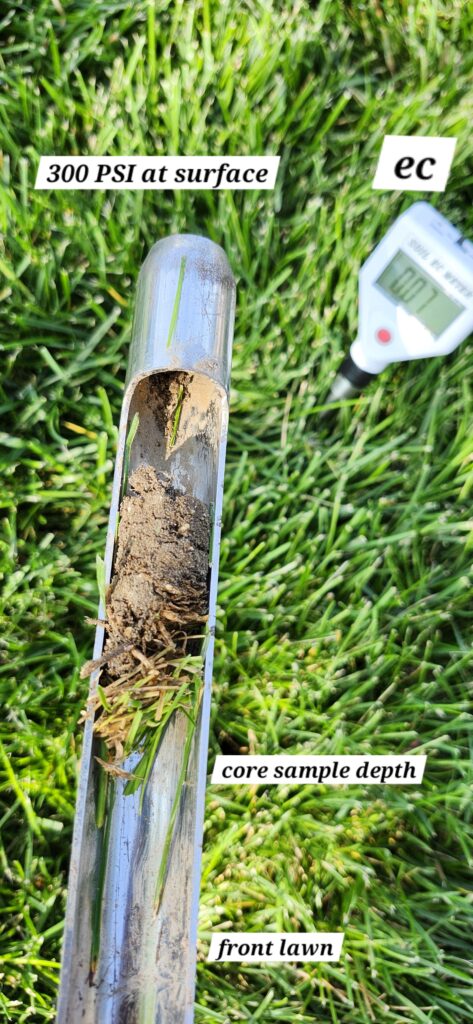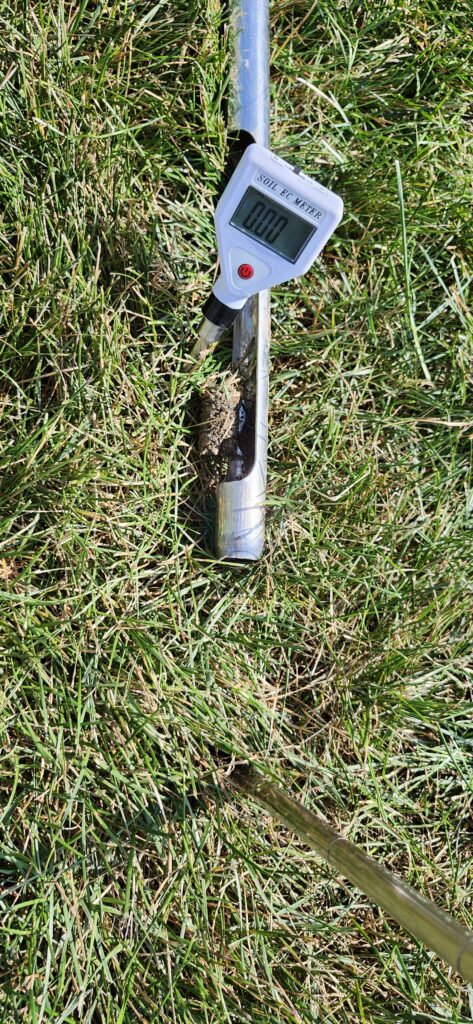Date: July 30, 2024
Evaluated by: Stangl’s Enviro Lawn Care
Property Overview
The homeowner contacted us to assess her property after investing over $100,000 in landscaping and hardscaping. The homeowner feels the landscaping company did not fulfill their contract, and with the anniversary date approaching in August 2024, she wanted a thorough evaluation. The property, originally owned by her son, had French drains in the back and, prior to being a subdivision, was dry crop farmland. This historical context provides insight into the soil’s current condition and challenges.
Assessment Findings

- Top Soil Application:
- Contract Discrepancy: The contract specified adding 25 yards of topsoil, but the home owner is unsure if this was done.
- Core Samples: Samples indicate minimal organic matter and severe compaction, suggesting insufficient carbon/organic matter addition.
- Plant Health:
- Dying and Stressed Plants: Several plants have died, and others show significant signs of stress, primarily due to poor soil conditions and compaction.
- Soil Compaction and Infiltration:
- Poor Infiltration: The back area, characterized by heavy clay and legacy issues, shows poor water infiltration.
- Penetrometer Readings:
- Front and Back Areas: 300 PSI from the surface down to 3 inches.
- Right Side (No Traffic): 6+ inches of moist soil, indicating better conditions.
- Optimal Compaction: Should be around 150-200 PSI. Current readings of 300 PSI restrict air, water, and root penetration, leading to plant stress and poor growth.
- Soil Moisture and Composition:
- Dry and Compacted Soil: The front and back areas show dry, compacted soil with minimal organic matter.
- Better Conditions in Non-Traffic Areas: The right side, with no traffic, shows better moisture retention and soil health.
- Water Management:
- Irrigation System: Installed with the landscape, including drip irrigation in flower beds.
- Compaction Issues: Poor soil structure leads to water runoff, inadequate infiltration, and uneven watering.
- Electrical Conductivity (EC) Readings:
- Right Side: 0.29
- Front: 0
- Back: 0.07
- Optimal EC: Readings for healthy soil should be between 0.3 to 0.9. Low EC readings indicate poor biological activity and potential for future problems like pests and diseases.

Recommendations for Soil Health Improvement
- Soil Aeration:
- Alleviate Compaction: Regular aeration to alleviate compaction and improve air and water penetration.
- Optimal Compaction: Focus on areas with high compaction (300 PSI) to reduce to optimal levels (150-200 PSI). Aeration alone won’t suffice; use our Pelletized Ultimate Compost (PUC) and Nature’s Brew to enhance soil health.
- Soil Amendments:
- Calcium Application: Incorporate calcium within our Nature’s Brew to relax soil compaction and improve soil structure.
- Organic Matter Addition: Use PUC as a source of carbon to improve soil fertility and moisture retention. We are the only company that applies this.
- Microbial Extracts: Increase microbial activity and rejuvenate soil health with Nature’s Brew extracts.
- Water Management:
- Proper Irrigation Practices: Avoid water runoff and promote even water distribution. Monitor and adjust irrigation based on soil moisture levels and plant needs (Goldilocks Principle – not too much, not too little, but just right).
- Long-term Soil Health:
- Reduce Chemical Inputs: Limit the use of chemical fertilizers and sprays that deplete soil life and carbon content.
- Promote Organic Practices: Adopt organic and regenerative practices to build sustainable soil health.
- Proper Mowing Practices: Avoid scalping and maintain optimal turf performance to prevent soil overheating and degradation.

Soil Biology and Compaction
- Rhizophagy Cycle:
- Natural Nutrient Uptake: Plants absorb microbes from the soil into their roots. These microbes are partially digested, releasing nutrients directly to the plant. Chemical fertilizers and pesticides disrupt this cycle, killing beneficial soil microbes and hindering nutrient cycling.
- Biological Impacts of Compaction:
- Anaerobic Conditions: Compaction leads to poor soil aeration, resulting in anaerobic conditions where oxygen is limited. This creates harmful substances like acids, vinegar, and formaldehyde, restricting root growth and promoting disease and pest issues.
- Salt Accumulation: Compacted layers trap water and minerals (salts) above them. During summer, water evaporates and salts wick upwards, causing surface salinization and harming plants.
- Carbon Dynamics:
- Carbon Depletion: Landscaping activities expose soil, creating conditions for carbon oxidation. This depletes soil organic matter, critical for maintaining soil structure, fertility, and microbial activity.
- Nitrogen Fertilization: Excessive nitrogen reduces soil carbon content by accelerating the decomposition of organic matter, leading to long-term soil degradation and increased salinity.
Conclusion
Compaction is a silent killer in landscaping, often exacerbated by conventional practices. At Stangl’s Enviro Lawn Care, we prioritize soil health through sustainable practices, focusing on microbial activity, soil structure, and proper irrigation. Unlike other companies that apply NPK fertilizers without understanding the long-term consequences, we use advanced tools like penetrometers, EC meters, and microscopes to assess and address soil health comprehensively. By implementing our recommendations, we can transform your landscape into a thriving, sustainable environment.
For further assistance and to implement our solutions, please contact us. We are here to help you achieve the landscape of your dreams.
Contact Information:
Stangl’s Enviro Lawn Care
info@stangls.com